187 search results - page 25 / 38 » Bidirectional Dynamics for Protein Secondary Structure Predi... |
BIOINFORMATICS
2010
13 years 8 months ago
2010
Motivation: To test whether protein folding constraints and secondary structure sequence preferences significantly reduce the space of amino acid words in proteins, we compared th...
JCB
2006
13 years 7 months ago
2006
Protein fold recognition is an important step towards understanding protein three-dimensional structures and their functions. A conditional graphical model, i.e., segmentation con...
BMCBI
2006
13 years 8 months ago
2006
Background: The emerging field of integrative bioinformatics provides the tools to organize and systematically analyze vast amounts of highly diverse biological data and thus allo...
RECOMB
2006
Springer
14 years 8 months ago
2006
Springer
mRNA molecules are folded in the cells and therefore many of their substrings may actually be inaccessible to protein and microRNA binding. The need to apply an accessability crite...
ISMB
1996
13 years 9 months ago
1996
For transmembrane proteins experimental determina-tion of three-dimensional structure is problematic. However, membrane proteins have important impact for molecular biology in gen...


